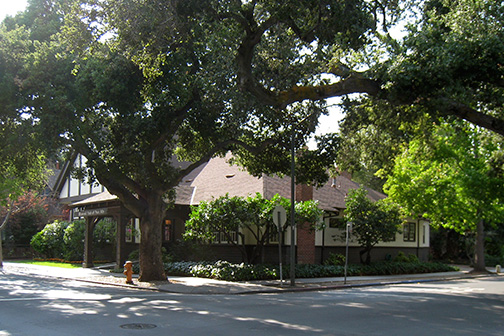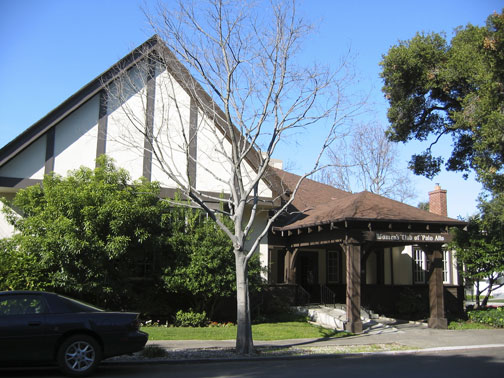 Palo Alto Stanford Heritage
Palo Alto Stanford Heritage When the Palo Alto Woman’s Club chose architect Charles Edward Hodges (1866-1943) to design their new Clubhouse at the corner of Cowper and Homer he had already designed numerous sororities, fraternities and residences (both at Stanford and in Palo Alto).
It’s interesting to note that the house at 340 Coleridge, built the year before the Woman’s Club was started, has a bay window and half timbering similar to the Woman’s Club.
The Laying of the Cornerstone
The cornerstone, engraved and donated by George McLachlan was laid in a June 1916 ceremony. On June 10, 1916 the Palo Alto Times opined: “We believe the Woman’s Club in starting this building is preparing to contribute a great deal to the future of this city.”

By 1916 when the club was built, most of the surrounding lots had structures on them. Hodges’ modest, eclectic Tudor-craftsman clubhouse design fit well into the residential neighborhood. The building is finished in stucco with a painted wood band of lap siding at the base. The windows across the front sit on the band, while the windows along the side are raised above the band.

Most of the exterior is craftsman in detail. The porch/entry pavilion (referred to as a porte-cochere in some of the Club’s records) is supported by simple, large, square columns. Heavy beams are supported by simple braces. Rafter tails are visible under the gutters.
Only the front 1 ½ story gable end over the ballroom has some Tudor elements: some half timbering and a steeper roof than the rest of the building.
The ballroom has a simple board and batten wainscot on 3 sides.
The fourth wall is a stage with a simple painted wood surround. Part of the surround is obscured by the ceiling which was lowered in 1973.
An intriguing feature is that the drawer at the bottom of the stage front opens to create a conductor’s platform
In 1926, The Advertising Agency paid the club $500 to hang an olio curtain painted with ads paid for by local business. It was a common practice across the United States to use these curtains in theaters or civic auditoriums for advertising. The olio curtain is a screen which rolls up from the bottom and is usually painted with a pastoral scene in the middle and surrounded by advertising-- much more attractive than the ads shown before movies today!
In 1973 the exterior ballroom sidewall was bulging. It was discovered that the roof had been re-roofed several times over older roofs and some of the structural support was broken. During the repair, the ceiling was lowered and the coving was lost. The light fixtures were replaced with more ornate pendants.
Just off the ballroom, the Fireside Room has a fireplace covered with brown salt-glaze tiles manufactured for a short time by the Steiger Terra Cotta and Pottery Company in South San Francisco. Incidentally, these tiles are similar to those on a fireplace at Villa Montalvo.
Several changes were made in 1957. In the boardroom, a storage cabinet and a window seat were removed.
In 1999 a cabinet and seat were added. The remodel plans also called for covering the brick fireplace with flagstone and covering the walls with mahogany plywood panels. Luckily, this was not done and the fireplace remains intact with a removable stove insert.
The bathrooms were entirely remodeled in 1957 with design elements that were in common use then, but incompatible with the historic character of the building. A high, horizontal, aluminum frame window replaced a pair of double hung windows. The club is now remodeling the bathrooms and replacing the aluminum window with ones that match the original double hung. The club is trying hard to make this remodel timeless while meeting new building code and accessibility requirements.
Despite the changes the building still retains is architectural integrity inside and out.
The windows across the front sit on the band Cowper side of Woman’s Club while the windows along the side are raised above the band. Porte Cochere Most of the exterior is craftsman in detail. The porch/entry pavilion (referred to as a porte-cochere in some of the Club’s records) is supported by simple, large, square columns. Porte Cochere detail Heavy beams are supported by simple braces. Rafter tails are visible under the gutters. Woman’s Club Exterior Only the front 1 ½ story gable end over the ballroom h as some Tudor elements: some half timbering and a steeper roof than the rest of the building. Photo Ballroom A view of the Ballroom The ballroom has a simple board and batten wainscot on 3 sides. Ballroom Stage The fourth wall is a stage with a simple painted wood surround. Part of the surround is obscured by the ceiling which was lowered in 1973. Conductor Podium An intriguing feature is that the drawer at the bottom of the stage front opens (much more than shown) to create a conductor’s platform Olio Screen In 1926 The Advertising Agency paid the club $500 to hang an olio curtain painted with ads paid for by local business. It was a common practice across the United States to use these curtains in theaters or civic auditoriums (or auditoria, if you prefer) for advertising. The olio curtain is a screen which rolls up from the bottom and is usually painted with a pastoral scene in the middle and surrounded by advertising. I think it’s much more attractive than the ads shown before movies today. Ballroom in the 1950’s Ballroom 2009 In 1973 the exterior ballroom sidewall was bulging. It was discovered that the roof had been re-roofed several times over older roofs and some of the structural support was broken. During the repair, the ceiling was lowered and the coving was lost. The light fixtures were replaced with more ornate pendants. Entry Fireside Room Just off the ballroom, the Fireside Room has a fireplace Fireside room fireplace Side of Fireplace covered with brown salt-glaze tiles. Ellen and Tom Wyman identified these tiles as ones manufactured for a short time by the Steiger Terra Cotta and Pottery Company in South San Francisco. Incidentally, these tiles are similar to those on a fireplace at Villa Montalvo. Several changes were made in 1957. Boardroom In the boardroom, a storage cabinet and a window seat were removed. In 1999 Barbara Carlitz designed the cabinet and seat you see in the photo. Elevation of Fireplace The remodel plans also called for covering the brick fireplace with flagstone and covering the walls with mahogany plywood panels. Boardroom Fireplace Luckily, this was not done and the fireplace remains intact with a removable stove insert. Bathroom window in 50’s remodel The bathrooms were entirely remodeled in 1957 with design with design elements that were in common use then, but incompatible with the historic character of the building. A high, horizontal, aluminum frame window replaced a pair of double hung windows. Cowper side of Clubhouse Corner of Homer and Cowper The club is now remodeling the bathrooms and replacing the aluminum window with ones that match the original double hung. We are trying hard to make this remodel timeless while meeting new building code and accessibility requirements. Photo exterior We are fortunate that despite the changes the building still retains is architectural integrity inside and out.
From a talk by Aino Vieira da Rosa, October 4, 2009
E-mail us at either webmaster@pastheritage.org or president@pastheritage.org.
![]() Palo Alto Stanford Heritage—Dedicated to the preservation of Palo Alto's historic buildings.
Palo Alto Stanford Heritage—Dedicated to the preservation of Palo Alto's historic buildings.
Copyright © 2015 Palo Alto Stanford Heritage. All rights reserved.